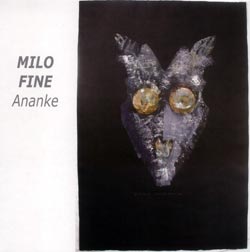
Pianist Milo Fine in a two part release of his "Ananke" work in trio and solo settings, playing inside and outside the piano, and with electronics and voice.
Out of Stock
Quantity in Basket: None
Log In to use our Wish List
Shipping Weight: 5.00 units
Sample The Album:
Milo Fine-piano (1-7), electronics & voice (1-3)
Jaron Childs-alto saxophone (1-3)
Davu Seru-drum set (1-3)
Click an artist name above to see in-stock items for that artist.
UPC: B002E5I2RM
Label: Emanem
Catalog ID: 5003
Squidco Product Code: 11206
Format: CD
Condition: New
Released: 2009
Country: Great Britain
Packaging: Cardboard Gatefold 3 Panels
Digital concert recordings made in Minneapolis (Acadia Cabaret Theater) by Milo Fine. Tracks 1-3: December 11, 2007. Tracks 4-7: September 5, 2006.
Excerpts from sleeve notes:
Pianos
"The first (and only) acoustic piano in my parent's home was an upright in mediocre condition. Not that I knew any better. Not that it mattered. The point was interfacing with the instrument, doing the work, making music. I simply didn't, and still don't have any bourgeoise aspirations. So, while I enjoy interfacing with grand or baby grand pianos, having, through a set of fortuitous circumstances, acquired a baby grand for use at home in 2003 (and continue to be absolutely outraged that pianists working outside classical and pop fields are relegated to playing back-up instruments at so-called prestigious/formal venues), I have in no way lost my respect for piano remains, which are, in the final analysis, nothing but unintentionally prepared pianos, relegated to 'elsewhere'.
The once a week 'Improvised And Experimental Music' series at the Acadia Cafe in Minneapolis was a direct extension of Unum, curated by Davu Seru from 2000 to 2001. Set up somewhat like an English pub; with a front room for dining / drinking, and a multi-use space to the side, where all manner of music and theater was presented, Acadia had a pleasant, inviting ambiance. The owner was, unfortunately and predictably, pretty much of a philistine, but, for the most part, easy to avoid. Still, in line with, it seems, almost every venue, he insisted that the series feature several groups per evening. Initially adhering to this requirement, as long as I had a say in who I shared an evening with, I eventually found my way around the 'law' by booking two or three different groups (all with me) on a given evening. (You see, I actually like to play, underscored by the pragmatic reality that, if I'm going to haul and set up all manner of equipment, I might as well dig in.)
Like too many spaces presenting music these days, there was, at first, no piano. However, in early 2006, as I understand it, Jordan, a volatile, sensitive young woman who worked at Acadia, donated an old piano she had sitting around her apartment. Though her piano had been tuned after the move, it was still more remains than intact. We cultivated a rewarding relationship over the ensuing months; to the point where I elected to do a set of solo piano presented here more or less intact. Interestingly, as the piano 'deteriorated', so did the series' relationship with the owner, and, as it turns out, the owner of Acadia with the owner of the building in which it was housed. Thus, Acadia elected to relocate and leave the series behind. The trio set here is from one of the final evenings. Fully aware that the piano would most likely be trashed or left to rot once Acadia moved, I resolved to really get into the innards of that wonderful beast. That Davu and Jaron were part of this so-called last hurrah was fitting, as Unum had begun with them seven years earlier.
Alto saxophonists
The number of times Jaron Childs, a striking and accomplished visual artist, has quit playing music (and actually sold his saxophone, only to re-buy it; ultimately ending up with one on 'permanent loan'), exemplifies a particular type of struggle. Essentially self taught, Jaron's port of entry to improvised music was, for want of a better term, classical in nature. Thus, while playing an instrument mostly associated with jazz, part of his struggle has to do with sidestepping that sound; to wit, Jaron's instrument is the alto saxophone, rather than the alto sax. Additionally, his improvisational work is informed by the minimalist school (the spare sounds / limited materials, rather than ostinato-based branch), which saw a huge resurgence in recent years. My work, on the other hand, has always been much less beholden to any particular school or movement.
I believe Jaron's and my first experience playing together was a sextet set at Acadia on February 10, 2004, where, not surprisingly, we played past one another in the group, but in a surprising fashion with my opting for a more spare approach and he being more extroverted. The same thing happened some time later at the start of a private session at my home instigated by Jaron. But, over the course of that evening, without any discussion, we found nicely juxtaposed common ground. My approaching Jaron and Davu for the set here was fueled by several variables; Jaron's and my evolving dynamic, Davu's and my extremely fecund collaborative history dating back to 2000, Jaron and Davu's longstanding relationship, and, perhaps most immediately, the fact that Charles Gillett had, at this time, begun to curtail his public appearances (meaning that I could, that evening, 'take his chair' as it were).
Since then, thanks to Andrew Lafkas, I participated in a wonderful concert with Jaron, Davu, tuba player Stefan Kac, and Andrew on April 25, 2008. And, while it doesn't seem likely that we will be frequent collaborators, I look forward to further work with Jaron; that is, if his current horn's owner doesn't call in the loan.
Editing
Improvisation is composition in real time. More accurately, improvisation reveals the process of composition. Interfacing intuition and discipline, choices are made, that, while not necessarily being 'perfect' (as if that were possible, or even desirable), nonetheless seek to maintain a design that has much to do with chaos theory as formal organization. Thus, moments or sections which might appear to be less vital can be, and, for the serious practitioner, often are essential ingredients for the music's resonance and development. Put another way, unlike most formally composed music, improvisation gives weight to the backward glance where what comes after illuminates the necessity of the previous. Therefore, ideally, published work of improvised music should be presented in toto. Obviously, for many reasons, this isn't practical. But, in attempting to respect the process, I've at least always adhered to editing in terms of selecting start and end points.
On the other hand, through conversations as well as liner notes he's written, I'm well aware of Martin Davidson's penchant for surgical operations; the removal of what he considers to be 'below par' material. And while he has previously acquiesced to my preferred approach in our past collaborations, it was evidently time for a curve ball; or, more likely, he just wanted to get on to a project he had in mind without any aesthetic hand-wringing on my part. Indeed, I was surprised when a CD-R entitled 'Never Mind the Piano, the Pianist is Fine' showed up in the mail. (I periodically forward him material, and while he had mentioned especially liking the trio session here, he didn't give me any inkling that he was seriously considering publishing it.)
Putting the CD in the player, however, I noted that the running time was over 78 minutes. As I knew the trio set clocked in at about an hour (and less, once applause and the like were excised), I was mystified. But, upon listening, it became clear that he had annexed the solo piano set from the year before. Brilliant move, that. Now, given that I remembered the piano set to be around 30 minutes, if Martin hadn't mentioned his snipping in an e-mail, I don't now that I would have noticed. In any case, a little surgery was necessary to get the running time under 80 minutes, and as I thoroughly enjoyed the music as presented, there was, particularly given the respect and support accorded to me by Martin, no question of my acquiescing to his approach; at least this time around."-Milo Fine, Emanem
Artist Biographies
Track Listing:
1. Ananke Trio: part 1 25:44
2. Ananke Trio: part 2 10:09
3. Ananke Trio: part 3 18:01
4. Ananke Solo: part 1 6:34
5. Ananke Solo: part 2 3:52
6. Ananke Solo: part 3 8:02
7. Ananke Solo: part 4 6:13
EMANEM & psi
Improvised Music
European Improv, Free Jazz & Related
Piano & Keyboards
London & UK Improv & Related Scenes
Free Improvisation
Trio Recordings
Search for other titles on the label:
Emanem.



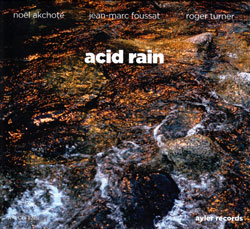
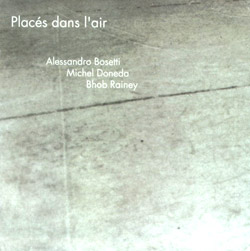
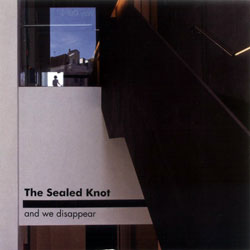
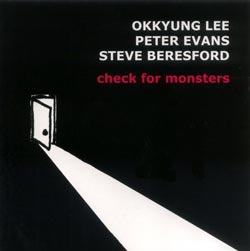
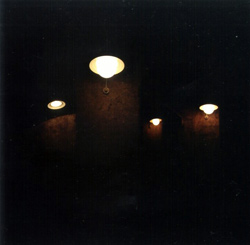














![Barker / Parker / Irabagon: Bakunawa [VINYL]](https://www.teuthida.com/productImages/misc4/35533.jpg)
![Blaser, Samuel / Marc Ducret / Peter Bruun: Dark Was The Night, Cold Was The Ground [VINYL 10-inch]](https://www.teuthida.com/productImages/misc4/35492.jpg)










![Warren, Kenny (Warren / Hoffman / Ellman): Sweet World [VINYL]](https://www.teuthida.com/productImages/misc4/35451.jpg)


![Blake, Ran / Dave Knife Fabris: Live Amsterdam 2006, First Visit [CD + POSTCARDS]](https://www.teuthida.com/productImages/misc4/35275.jpg)
![Sanna, Claudio: Compositori Sardi Contemporanei II [2 CDs]](https://www.teuthida.com/productImages/misc4/35317.jpg)












![Nevai, Nandor: <<The PRICE of FRONTIER>> Book 1: FULK [BOOK + 4 CDs]](https://www.teuthida.com/productImages/misc4/35464.jpg)
![Nevai, Nandor: <<The PRICE of FRONTIER>> Book 2: MARTIAL [BOOK + 4 CDs]](https://www.teuthida.com/productImages/misc4/35465.jpg)
![Nevai, Nandor: <<The PRICE of FRONTIER>> Book 3: JASSOM [BOOK + 4 CDs]](https://www.teuthida.com/productImages/misc4/35466.jpg)
![Nevai, Nandor: <<The PRICE of FRONTIER>> Book 4: HARD-WON [BOOK + 4 CDs]](https://www.teuthida.com/productImages/misc4/35467.jpg)

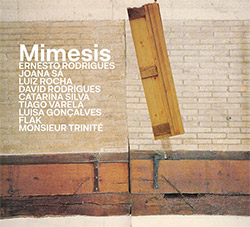




![DNS: Taking Big Bites Of The Khandas Three Cafes Deep [2 CDs]](https://www.teuthida.com/productImages/misc4/35334.jpg)




![Cleaver, Gerald: The Process [VINYL]](https://www.teuthida.com/productImages/misc4/34966.jpg)




![Alva Noto: HYbr:ID II [VINYL 2 LPs]](https://www.teuthida.com/productImages/misc4/35201.jpg)

![Baron, Derek / Luke Martin: Distinct and Concealed [CASSETTE + DOWNLOAD]](https://www.teuthida.com/productImages/misc4/35079.jpg)

![Lyle, Erica Dawn : Colonial Motels [CASSETTE + DOWNLOAD]](https://www.teuthida.com/productImages/misc4/35080.jpg)







![Alva Noto: HYbr:ID III [VINYL 2 LPs]](https://www.teuthida.com/productImages/misc4/35011.jpg)
![Kubisch, Christina / Trondheim Voices: Stromsanger 2022 For Six Voices And Electromagnetic Waves [VINYL]](https://www.teuthida.com/productImages/misc4/34628.jpg)








![Zurria, Manuel: Fame di Vento [3 CDs]](https://www.teuthida.com/productImages/misc4/35167.jpg)

![Granberg, Magnus / Nattens Inbrott / Skogen: Holde Traume, Kehret Wieder! [2 CDs]](https://www.teuthida.com/productImages/misc4/35038.jpg)
![Frey, Jurg: Outermost Melodie [2 CDs]](https://www.teuthida.com/productImages/misc4/35039.jpg)

![Pavone, Jessica: Reverse Bloom [VINYL]](https://www.teuthida.com/productImages/misc4/34895.jpg)




![Modney (Modney / Wooley / Gentile / Roberts / Pluta / Symthe / ...): Ascending Primes [2 CDs]](https://www.teuthida.com/productImages/misc4/34852.jpg)








![Elephant9 with Terje Rypdal: Catching Fire [VINYL 2 LPs]](https://www.teuthida.com/productImages/misc4/35355.jpg)
![Deerlady (Obomsawin, Mali / Magdalena Abrego): Greatest Hits [VINYL]](https://www.teuthida.com/productImages/misc4/34876.jpg)




![Haino, Keiji: Black Blues [2 CDs]](https://www.teuthida.com/productImages/misc4/35109.jpg)



![Surplus 1980: Illusion of Consistency [CD]](https://www.teuthida.com/productImages/misc4/35069.jpg)
![Staiano, Moe: Away Towards the Light [VINYL + DOWNLOAD]](https://www.teuthida.com/productImages/misc4/35037.jpg)
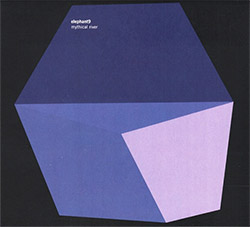



![Caveira (Gomes / Sousa / Abras / Ferrandini): Ficar Vivo [VINYL]](https://www.teuthida.com/productImages/misc4/34643.jpg)
![Gregg, J. J. / David Van Auken: Lunar Prairie [CD w/ DOWNLOAD]](https://www.teuthida.com/productImages/misc4/34611.jpg)

![Coultrain: Mundus [VINYL]](https://www.teuthida.com/productImages/misc4/32439.jpg)
![Mattin: Songbook #6 [VINYL]](https://www.teuthida.com/productImages/misc4/27317.jpg)
![Punkappella: Wake Up [7-inch VINYL]](https://www.teuthida.com/productImages/misc4/17519.jpg)
![Residents, The: WARNING: UNiNC.: Live And Experimental Recordings 1971-1972 [VINYL 2 LPs]](https://www.teuthida.com/productImages/misc4/31521.jpg)
![Coultrain: Phantasmagoria [VINYL]](https://www.teuthida.com/productImages/misc4/30142.jpg)
![Lennon, Sean Ono: Asterisms [VINYL]](https://www.teuthida.com/productImages/misc4/34517.jpg)

![Rotem Geffen: The Night Is The Night [VINYL]](https://www.teuthida.com/productImages/misc4/34631.jpg)
![Coley, Byron: Dating Tips for Touring Bands [VINYL]](https://www.teuthida.com/productImages/misc4/17906.jpg)

![Lost Kisses: My Life is Sad & Funny [DVD]](https://www.teuthida.com/productImages/misc4/lostKissesDVD.jpg)